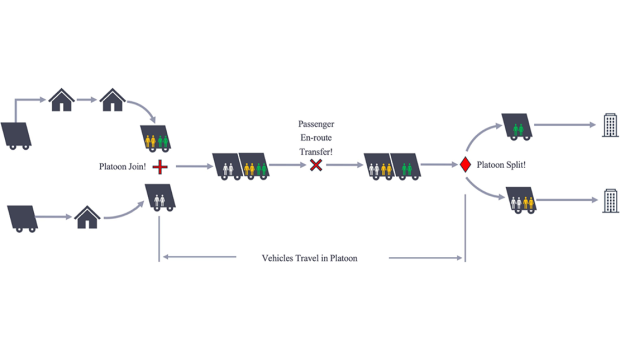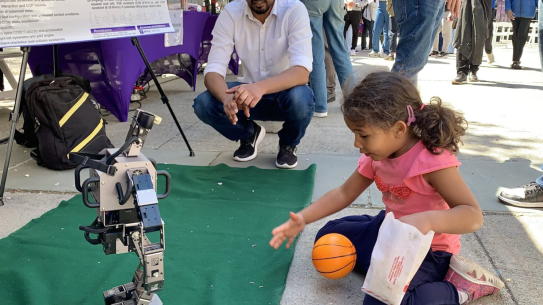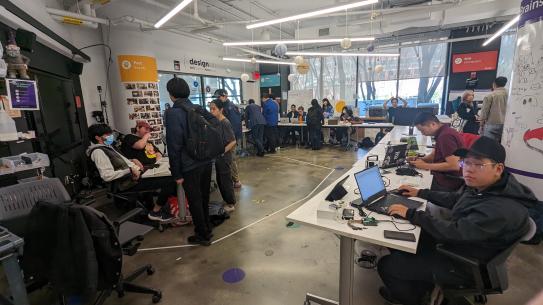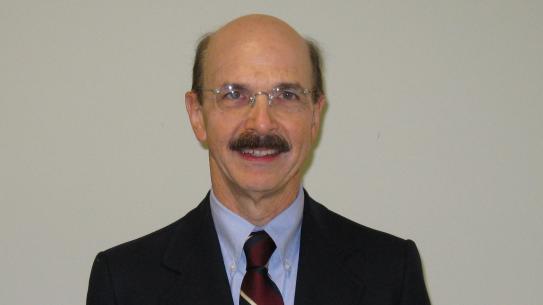New mathematical model optimizes modular vehicle fleet routes

A diagram from the paper illustrates two independent modular vehicles picking up passengers from different locations, then attaching together allowing passengers to transfer between the two vehicles in motion, before the vehicles split from each other and carry the passengers to separate destinations.
Researchers at NYU Tandon School of Engineering’s C2SMART Center have developed an algorithm to plan the most efficient routes for modular vehicle (MV) fleets — specially-designed vehicles that attach and detach from one another as they move people around cities — removing a significant obstacle to making this type of transportation system a reality.
In a paper published in Transportation Research Part C: Emerging Technologies, the researchers employ a mathematical model called MILP (Mixed Integer Linear Programming) to optimize the service time for the passengers and the travel cost for the vehicles in an MV system. The model factors in passenger pickups and deliveries, en-route transfers, and variable capacity of the MVs to identify the best routes and schedules for the attachments and separations of the vehicles.
Conventional mass transit and demand-responsive transportation systems can face challenges accommodating fluctuations in traveler demand, leading to long travel times, energy inefficiencies, traffic congestion and financial waste.
Low-capacity vehicles like vans may be slow and overcrowded in peak times. High-capacity vehicles like buses may be largely unoccupied when demand is low. On-demand services like paratransit often deliver only one passenger at a time, making them expensive to operate.
MVs offer a flexible and efficient alternative. The independent vehicles in MV fleets can connect while in motion, creating platoons that travel as one unit until the vehicles detach. According to research lead Joseph Chow, Institute Associate Professor in the Department of Civil & Urban Engineering and the Deputy Director of C2SMART, MVs can move people faster, with less energy consumption and operational expenses than many conventional systems.
“MVs offer a promising alternative to move people more efficiently in certain situations,” said Chow, who collaborated on the research with NYU Tandon Ph.D. student Zhexi Fu. “Imagine, for instance, employees at the same company. The individual vehicles could pick up people who live within similar enclaves, and join together in a platoon to deliver the entire group to its workplace. MVs also have significant potential to improve on-demand transportation that delivers people door-to-door, including those that serve people with disabilities.”
Currently, no city has an MV system in use, although Next Transportation Systems is piloting a MV test in Dubai now. According to Chow, the inability to track and route MV fleets has been a significant roadblock to potential real-world adoption. To build its routing model, the C2SMART team used the Anaheim network, a traffic simulation of Anaheim, California.
The research on MV routing is the latest in a long series of studies Chow has conducted around urban mobility. Among his previous studies include examinations of Dial-a-Ride programs, e-scooter usage, and urban bus networks. Chow’s new research also advances the mission of C2SMART, a U.S. Department of Transportation (US DOT) Tier 1 University Transportation Center (UTC) designated to address the US DOT priority area of Congestion Reduction.






